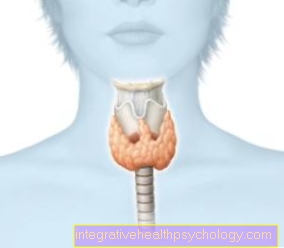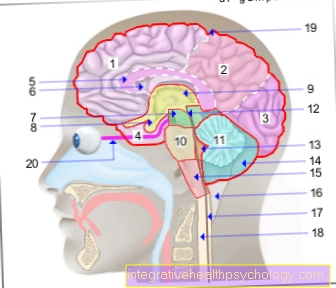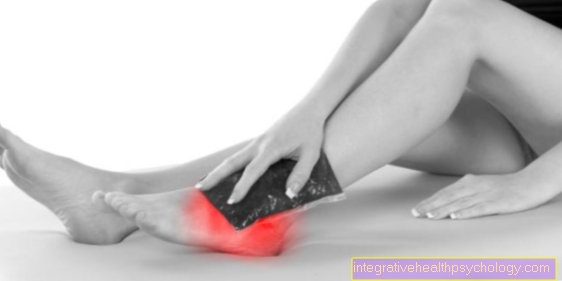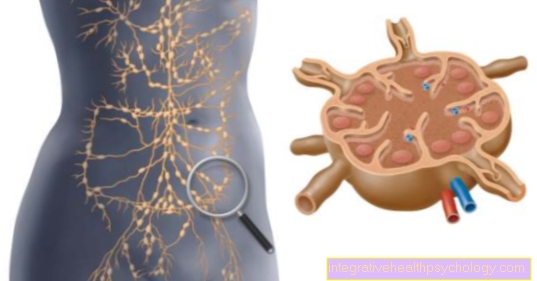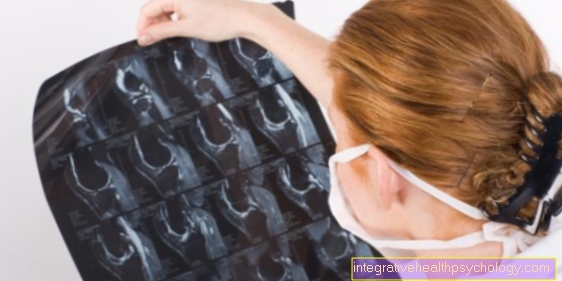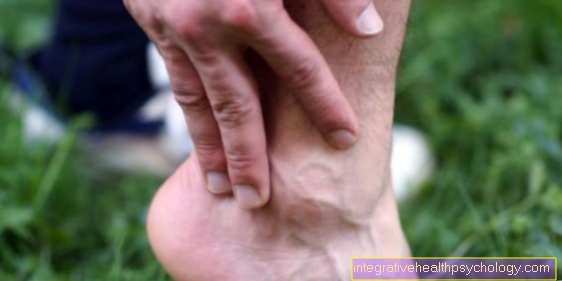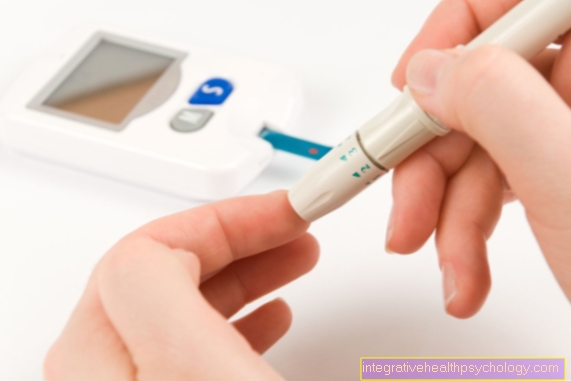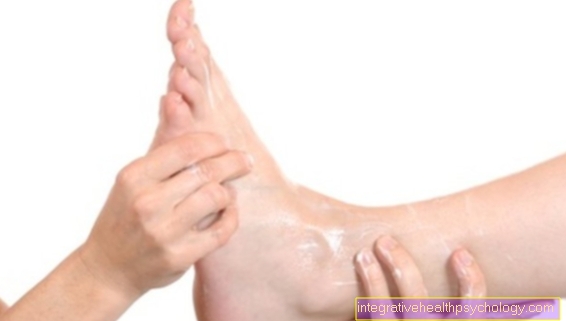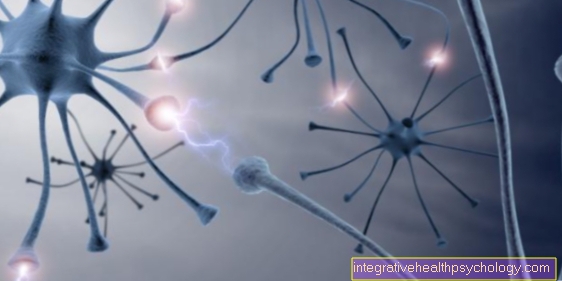Symptoms of a herniated disc of the cervical spine
introduction
The symptoms of a herniated disc of the cervical spine can vary greatly in their severity and intensity.
If a herniated intervertebral disc exerts pressure on the nerves that emerge in the cervical spine, in addition to pain in the neck, shoulder and arm area, numbness and, in the worst case, paralysis in the areas of the neck and upper body caused by the damaged nerve.

Pain
Due to the incident of damaged parts of the affected intervertebral disc, there is an enormous pressure load in the root canal of the cervical spine.As a result, there is the possibility that certain nerve roots no longer have enough space and are narrowed by the intervertebral disc. Depending on the strength with which the nerve root is compressed, the pain felt by the patient can vary in character. In some cases, the pain that occurs can be pinpointed, occurs suddenly, and can be described as sharp, shooting, and stabbing. In contrast, subliminal, dull pain can occur that is very difficult to localize.
In most cases, the pain is mainly in the neck and shoulder area and can sometimes spread over the entire arm to the individual fingers. Radiation in the head is also possible. Moving the head, both forwards and backwards, and twisting it, often increases the pain. Many patients also report increased pain in a lying position.
In order to escape the pain and to counteract it, the patients often adopt constrained postures, which allow the pressure on the affected nerve root to be temporarily relieved. The poor posture adopted leads to tension in the shoulder and neck area, which, in addition to neck pain and stiffness, can also be accompanied by dizziness and headaches. If no adequate treatment is initiated, the pain can become chronic.
Arm pain
A herniated disc often results in radicular pain. In this case, radicular means that the pain occurs in the area covered by one or more nerves. In the case of a herniated disc, the nerve roots are crushed.
The area that is supplied by these nerves then hurts, is paralyzed or can no longer perceive anything. The cervical spine consists of the spinal cord segments C1-8, from which the respective nerves, the so-called spinal nerves, emerge. The spinal nerves C5-Th1 form the brachial plexus, a large network of nerves that supplies the entire shoulder and arm muscles. If there is a narrowing of a segment in the lower area of the cervical spine, there are certain symptoms in the arm.
The pain can radiate from the neck over the shoulder to different areas of the arm. Are more deeply located nerve roots affected, even down to the fingertips. In addition, one has sensitivity disorders (sensation of touch, pain and temperature are reduced), a tingling sensation in the arm or numbness.
It can even lead to paralysis of individual muscles. Since every muscle is innervated by different segments, depending on the location, different muscle groups or individual muscles can fail. Pain tends to radiate over a larger area, but the paralysis of a muscle can usually tell exactly which vertebral body is affected.
Appointment with a specialist for a herniated disc?

I would be happy to advise you!
Who am I?
My name is dr. Nicolas Gumpert. I am a specialist in orthopedics and the founder of .
Various television programs and print media report regularly about my work. On HR television you can see me every 6 weeks live on "Hallo Hessen".
But now enough is indicated ;-)
A herniated disc is difficult to treat. On the one hand it is exposed to high mechanical loads, on the other hand it has great mobility.
Therefore, treating a herniated disc requires a lot of experience.
The aim of any treatment is treatment without surgery.
Which therapy achieves the best results in the long term can only be determined after looking at all of the information (Examination, X-ray, ultrasound, MRI, etc.) be assessed.
You can find me in:
- Lumedis - your orthopedic surgeon
Kaiserstrasse 14
60311 Frankfurt am Main
Directly to the online appointment arrangement
Unfortunately, it is currently only possible to make an appointment with private health insurers. I hope for your understanding!
Further information about myself can be found at Dr. Nicolas Gumpert
deafness
In addition to pain, numbness is a symptom that often occurs in herniated discs in the cervical spine. The feelings of numbness in the case of a herniated disc of the cervical spine can spread from the neck over the entire arm to the hands.
Deafness is usually described as a loss of perception of certain external stimuli. The patients often have the feeling that the arm can no longer be properly perceived and used by them. A loss of muscle strength is often associated with numbness. Feeling numb is a sign of decreased activity or loss of function in the affected nerves. Restricted blood flow in the arm area can also lead to a feeling of numbness.
Read more on the topic: Numbness from a herniated disc
Paralysis and "tingling"
The symptoms that manifest themselves in a herniated disc of the cervical spine also include abnormal sensations, which in the worst case can turn into paralysis. These abnormal sensations are often described as a persistent or recurring tingling sensation that spreads over the whole arm and feels like ants are walking over the skin.
The herniated disc of the cervical spine leads to increased irritation of the nerves. This overactivity of the nerve fibers is passed on via the sensitive nerve endings in the skin and thus triggers a stinging and pinching tingling sensation in certain skin regions. In many cases, the tingling sensation occurs before a feeling of numbness manifests itself as the disease progresses.
Read more on the topic: Tingling sensation from a herniated disc
fatigue
The brain is constantly working and consuming a lot of energy. It is therefore dependent on an adequate supply of nutrients and oxygen. It takes up 20-25% of all oxygen in our blood. Since it must never be undersupplied with oxygen, this value must always be kept fairly constant.
If the brain does not receive enough oxygen, this leads to fatigue in chronic cases, and even to unconsciousness in acute cases.
In addition to the carotid arteries, there is also the vertebral artery, which supplies the brain with blood. It arises from the subclavian artery (a large vessel for supplying the arm) and approaches the spine at about the level of the 6th cervical vertebrae. It runs in pairs in a kind of canal to the right and left along the cervical spine and from there it enters the skull.
A herniated disc can compress not only nerve roots but also vessels. Since the vertebral artery runs very close to the vertebrae, it can become narrowed in the event of a herniated disc. Less blood comes to the brain and therefore less oxygen, which explains the tiredness.
Shortness of breath
Our most important muscle for breathing is the diaphragm. Since the lungs cannot passively expand to take in air, the expansion of the lungs must be done with muscle work. The diaphragm sits under the lungs and separates the rib cage from our abdominal cavity. When the diaphragm tightens, contracts and moves further down. This creates a negative pressure in the chest, the lungs expand and air flows in.
The diaphragm is innervated by the phrenic nerve (from the spinal cord segments C3-5). If there is a herniated disc in this area, the diaphragm can be paralyzed on one or both sides. Difficulty breathing is usually only developed with bilateral paralysis.
Breathing can then only take place with the help of the auxiliary breathing muscles (muscles of the chest) and is therefore more difficult.
Visual disturbances
Visual disturbances can present themselves differently. For example, there may be flickering, you can no longer see clearly or even visual field defects. Visual disturbances can also occur in the course of a herniated disc in the cervical spine.
In this case, the cause of the disturbance is again an entrapment of a vessel, the vertebral artery. The blood flow to the eye, like that of the brain, is dependent on the so-called carotid arteries and the vertebral artery. With a (mostly one-sided) pinching of the vessel on the spinal cord, there is an insufficient supply of the eye.
However, these disorders occur very rarely.
a headache
Headaches associated with a herniated disc in the cervical spine can have different causes. On the one hand, the muscle tension or pain in the neck area can radiate to the head.
Another cause is the insufficient supply of blood due to an entrapment of the vertebral artery. This leads to lower blood pressure in the vessels that supply the brain. As a result, less oxygen and nutrients come to the brain. Since the brain is very dependent on this supply, it signals e.g. with a headache that it just can't work properly.
difficulties swallowing
The cervical plexus is a plexus of nerves that consists of the C1-3 spinal cord nerves. These nerves supply, among other things, the masticatory muscles, but above all the swallowing muscles.
There are many muscle groups that are essential to our swallowing act.
This also includes the infrahyoid muscles. The hyoid is our hyoid bone, a small bone that lies between the neck muscles under the lower jaw. The infrahyoid muscles connect the hyoid bone with the sternum. If these muscles contract, the hyoid bone is pulled down and the chyme can be transported through the pharynx into the esophagus.
If these muscles are paralyzed by a herniated disc in the C1-3 range, this leads to difficulty swallowing. But there will be many other muscles involved in swallowing, so there is no complete inability to swallow.
Jaw discomfort
There are many different muscles around the jaw that can cause a variety of movements. The cooperation of all these muscles is important for perfect chewing movements and the opening and closing of the jaw.
Almost all jaw muscles are innervated by different cranial nerves. These come directly from the brain and therefore have nothing to do with the spinal cord. One muscle, however, the geniohyoid muscle, is supplied by nerve branches from the cervical plexus (C1-3) from the spinal cord. This muscle is involved in the act of swallowing on the one hand, but also in the opening of the jaw on the other. A herniated disc in the area of C1 can therefore cause discomfort when opening the jaw.
A herniated disc that causes pain in the upper part of the cervical spine can also cause pain in the jaw. Anatomically, the cervical spine and the jaw are close to each other so that pain can easily radiate here.
nausea
Disc herniations often start slowly and insidiously. Therefore, the symptoms appear rarely or in a weakened form at the beginning, so that initially no attention is paid to the herniated disc.
The initially mild pain can then get worse. If the pain becomes unbearably severe, it can even lead to nausea. Herniated discs in the cervical spine can be a cause of the cervical spine syndrome (cervical syndrome). Dizziness and nausea are just a few of the symptoms that arise in this context.
Symptoms of a herniated disc of C5 / 6
Long-term pressure loads can damage the fibrous ring of the intervertebral disc. Weak spots develop through which the cartilage tissue of the intervertebral disc can escape and compress and narrow the nerve roots.
If this takes place in the area of the C5 / 6 nerve root, pain occurs that can extend from the neck to the arm and into the hand.
A compression of C6 is characterized by limitations in the function of the muscles that are responsible for arm flexion and an overall loss of strength in the muscles that are innervated by the nerve fibers of the affected nerve root. In many cases, sensory disturbances and numbness in the area of the thumb and index finger also occur.
Read more on the topic: Disc herniation at the level of C5 / 6
Symptoms of a herniated disc of C6 / 7
A herniated disc in the C6 / 7 area is associated in most cases with severe shooting pain in the neck and shoulder area. Above all, a loss of strength and restricted movement of the arm muscles, which are responsible for the extension, can be determined.
When the C6 / 7 nerve root is compressed, abnormal sensations occur in the area of the thumb, index and middle finger. Due to tension in the neck muscles, a herniated disc can lead to dizziness, headaches and concentration problems in this area as well.
Read more about this at: Disc herniation at the level of C6 / 7
Radicular symptoms
The herniated disc causes acute irritation or narrowing of the nerve root. The resulting pain spreads along the course of the nerve to the area of the area that is supplied by this nerve. In the area of the cervical spine, the arm would be particularly affected. The pain is clearly limited to the body region belonging to the nerve and in many cases increases in intensity, especially during the night.
In addition to the pain, radicular symptoms also include the occurrence of paresthesia.
Herniated discs of the cervical spine usually lead to a radicular syndrome less often than herniated discs of the lumbar spine.
What are pseudoradicular symptoms?
Pseudoradicular symptoms in connection with a herniated disc of the cervical spine are similar to radicular symptoms. Here, too, pain occurs that radiates into the arm, but a distinction must be made between the fact that it does not originate in the compression, i.e. narrowing of a nerve root.
In most cases, the pseudoradicular pain is due to a local cause. In a way, they simulate a herniated disc.
Sensitivity disorders / dermatomes
The dermatomes of the cervical spine are the areas of skin that are supplied by the nerve fibers of a specific spinal cord root.
8 spinal cord roots C1 - C8 arise in the area of the cervical spine. However, there is no dermatome that can be assigned to the first root of the spinal cord, as this does not supply any specific skin area, but only provides the control of movements.
In the case of herniated discs in the area of the cervical spine, the dermatomes are very helpful for diagnosis, since in the case of sensory disturbances or numbness in the skin areas of the individual dermatomes, conclusions can be drawn about the location of the defective disc.
Abnormal sensations in the area of the thumb and index finger would indicate increased pressure of the intervertebral disc on the C6 nerve root. Sensory disturbances in the middle fingers indicate a herniated disc at level C7 and sensory disturbances in the ring and little fingers at level C8.


.jpg)


